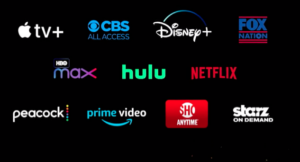In case you missed it, the Disney+ media streaming service launched earlier this month (November 12) for $6.99/month in the US, and in just 24 hours, the company claimed 10 million subscribers. – Wow!

If you see this as a testament to the legacy of Walt Disney and company, as pioneering geniuses, and perhaps trailblazers of the digital age (consider the achievements of WED, Imagineering, and MaPo et al.), you’re right, but it’s only half the story. The major trend perhaps begun in the US by HBO in the relatively short-lived cableTV heyday was (and still is) original content creation, and that’s just state-side.
The New Status Quo
In truth the BBC, NHK, and perhaps a dozen other broadcast icons throughout the world, pioneered original (historic) content and series based formats decades ago. The difference now is that, in the digital age of á-la-carte video streaming on demand (vsod), content converges with the “dramatic shift in the way people consume entertainment and information,” according to Disney’s Robert Iger. In an industry that is finally having its “aha-moment” and waking up to the reality that subscription attrition (cord cutting) in traditional pay-TV delivery it’s not just a “speed bump” but the new status quo.
What the digital age can do that, until now, could not be done, is to tailor content (and ads) with confidence to specific viewer preferences. The old broadcast model of knowing only 50% of ad dollars spend was effective (but not knowing which 50%) is gone the way of the horse and buggy. As PricewaterhouseCoopers (PWC) in their comprehensive entertainment entertainment media report states:
“The central theme of this growing world of media is that it’s personal and increasingly digital. And it’s one that is constructed by the individual for his or her own enjoyment and gratification, and delivered through personal devices. Companies, in turn, are tailoring their offerings and business models to revolve around personal preferences, using data and usage patterns to pitch their products not at audiences of billions, but at billions of [known] individuals.”
One look at traditional subscription TV and the verdict (in the US) is clear. PWC reports revenue of $94.6 billion in 2018 will contract at a -2.9% CAGR to $81.8 billion by 2023, “…due to a mature market and cord-cutting, largely resulting from SVOD (streaming video on demand) competition”. The group also reports a YOY decline of US TV advertising of -0.6%.
The United States, however, still remains the world’s biggest pay-TV market by some distance, accounting for 46% of the total global revenue in 2018. The company also states in their entertainment media report, “Traditional pay-TV providers continue to transform their business models, implementing strategies to help minimize churn. This includes a focus on offering value-added products and packages to drive loyalty (and profits) from core customers, while also launching slimmer or “skinny” bundles that appeal to the cost-conscious,” the group stated.
Make no mistake, this is a foundational shift we are experiencing, where revenue generated by streaming services will surpass worldwide theatrical revenue this year, in 2019, so says research firm Ampere Analysis, in a March 2019 VentureBeat story. And the video streaming market is valued at $30.6 billion by 2022, up from $22 billion last year, according to (PWC). (The group said cinema box office revenue in the US was $11.1 billion)
But beyond traditional films, it’s original content in series format that seems to be fuelling this new wave of content streaming platform launches. “To differentiate their services, companies have recently been investing billions of dollars in producing original content,” according to a March 2019 VentureBeat story.
Netflix (now at 51% of streaming network subscribers) spent $8.9 billion in original programming in 2017 and $12.04 billion in 2018. Netflix said it will continue “…producing original shows and movies for most of the markets where it operates,”according to the report.
AppleTV+ also recently launched with significant leverage it can bring to the streaming party, including:
- A $245 billion cash war chest
- Top A-list talent on board including: Oprah Winfrey, Steven Spielberg, Jennifer Aniston, Reese Witherspoon, Steve Carell, J.J. Abrams, Sara Bareilles, Kumail Nanjiani, Jason Momoa, Big Bird (yep even a Muppet or two)
- +300M paid subscriptions for Apple services and third-party offerings, (and that’s growing, up 60% from a year ago)
- Apple Music subscriptions growing at 50% (year-over-year)
So count Disney+ carving out 10 million subscribers in a single day and powerhouse AppleTV+ both new to the video subscription on demand “Matrix” (VSOD) as two of only a limited number of streaming services that will eventually make the cut. We see pricing, and original content as key drivers in the space, but if PWC is correct in their assessment, the true driver will be found in the Latin words that fittingly appear in the Matrix film: nosce te ipsum, temet nosce (“thine own self know”) “know thyself (rather know thy viewer) to win this race long term. – Stephen Sechrist
Nagra and Kaon Introduce Android TV Streaming Solution for Pay-TV Operators
How Game of Thrones Broke Streaming and Why We Need to Fix It
Removing the Barriers to Launching Netflix on Android TV
Will the Apple Lion Roar Again?
Amazon Prime, HBO and Now TV Face Decreasing Audiences

